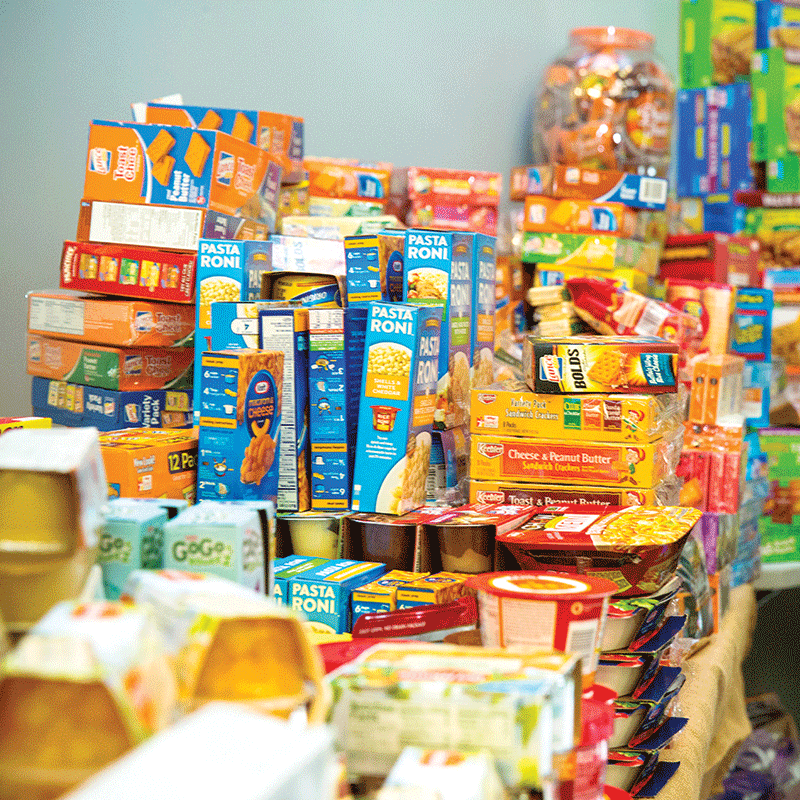Needy Families Find Food and Help from Organizations Around the Region
Hungry in Paradise

Life is what happens when we’re busy making other plans. A woman we will call JoAnna for the purposes this story didn’t foresee getting a divorce and becoming a single mother of five kids ranging in age from 2 to 20. Nor did she anticipate getting laid off from her job.
|
Jacqueline Ward Images
|
A college-educated 43-year-old, JoAnna grew up in a two-parent household where she routinely enjoyed a hot breakfast. She packed a lunch before heading off to school and gathered around the dinner table with her family in the evening to talk about the day’s events. She didn’t think three square meals a day was a luxury. She didn’t think much about food and where it came from at all — until her own kitchen cupboards were nearly bare.
Destin bills itself as the world’s luckiest fishing village, and the Emerald Coast is home to scores of restaurants, many staffed with top-notch chefs, ready to satisfy nearly any craving from Cajun to Cantonese. It seems as though food is everywhere we look and a part of nearly everything we do.
But throughout the Florida Panhandle, thousands of people like JoAnn aren’t sure where they’ll get their next meal.
“There are many things that make this an attractive place to live and go on vacation, but that doesn’t mean we are excluded from the realities of life,” said Tiffanie Shelton, the founder and executive director of Food For Thought, a nonprofit organization based in Santa Rosa Beach that provides food to children in Okaloosa and Walton counties. “People imagine hunger and they think of the Third World, they think of children with distended bellies and flies on their faces. But when you’re living paycheck to paycheck and something happens, the first thing that goes is the money for food.”
Shelton’s cheerful expression quickly turns serious when she talks about the importance of the work she and her volunteers, as well as other organizations around the region, are doing. She stumbled into this work five years ago. Then a single mom, Shelton first heard the phrase “food insecure” when she went to register her son for kindergarten at Butler Elementary School on 30A. One of the forms asked about her family’s access to food.
“My eyes were completely opened to what was going on in our community,” Shelton said. She asked the principal if there was something she could do to help. “I just went to the store and bought food for six kids. Word got out quickly. Six turned to 16 and then to 36. Kids began asking for help.”

Jacqueline Ward Images
Shelton told a few friends what she was doing and they, too, were eager to help. They began meeting at her home on Thursday nights to assemble bags of food for the kids to take on Fridays so they would have something to eat over the weekend. The children all received free or reduced-price breakfast and lunch at school but often had little to eat on Saturdays and Sundays and during holiday breaks.
After two years, Shelton and her friends were helping 125 kids every week. They had branched out to other elementary schools, and people in the community had begun to donate money and food items to their efforts. They registered as a nonprofit and, with financial support from the community, Shelton left her job and began working full time for Food For Thought.
Now in its fifth year, Food For Thought provides food for more than 800 children in 15 schools and two counties every week, including holidays and summer vacation, distributing more than 50,000 food items every month.
“I’d love nothing more than to be out of a job next year because no one needed our help anymore,” Shelton said. “But every year, more and more kids need our help.”
That’s a reality Jerry Ogle knows well. He has been putting food on strangers’ tables for 30 years.
“It’s not a question of ‘Is there hunger in this area?’ Yes, of course there is. There are hungry, needy people everywhere,” Ogle said. “The question is, ‘What are we being called to do about it?’”
In the summer of 1985, Ogle heard his pastor preach a sermon about how people needed to help the needy all year round, not just at the holidays. The message stuck with him, and afterward, Ogle told his pastor that he wanted to start a food outreach program.
With his pastor’s encouragement, Ogle raised about $5,000 and delivered meals to 30 families that year. Seeing that the need was larger than he realized, he was determined to keep up the effort — and Harvest House was born. Ogle soon realized that he needed a way to continually fund the food pantry, so he opened a thrift store, too. Now, 30 years later, Harvest House operates a food pantry and thrift store in Destin and helped start a residential facility, Hosanna House, where otherwise-homeless women develop knowledge and skills leading to a fresh start in life.
“You never know what’s going to happen here,” said Lori Joyner, executive director of Harvest House. “People just show up here, Monday to Friday, 10 to 12. Some days, more than 20 people will come through; some days, we’ll see only five. In an average month, Harvest House supplies food to 300 to 400 people. We see different people every month. Some get back on their feet and they don’t need our help anymore. Some show up here in Destin hoping for a better life, and sometimes they get here and can’t find work.”
Joyner said that the thrift store also functions as a place where people in need can get information on services in the area, and maybe just rest and relax for a few minutes. Like other food pantries in the region, Harvest House accepts donations of both money and food. It distributes food items that are donated and uses the money it receives to purchase food to give away.
“It’s in my heart to fight for families,” Joyner said. “People can’t make ends meet. Feeding the community keeps families together and keeps children more focused at school. It changes a community for the better when the community comes together to give food.”
She said that some families who come to the Emerald Coast on vacation spend the first day of their trip volunteering their time at Harvest House. And donations are collected at conventions held at the Emerald Coast Convention Center. Snowbirds who are familiar with Harvest House’s mission often bring their unopened, non-perishable food to donate to the pantry before they return home.
“We try not to throw anything away,” Joyner said. “Clothes that can’t be sold here are donated to a mission in Appalachia, West Virginia, and Mission Love Seeds accepts the Happy Meal toys that get donated and sends them to children in the Philippines.”
Through food pantries in Crestview, Fort Walton Beach and Niceville, Sharing and Caring also has been feeding hungry people in the region since 1985. The organization was founded by local churches and the Kiwanis Club.
“Sometimes it’s generational — people have grown up in this situation,” said Aleta Milton, volunteer president of the Sharing and Caring pantry in Niceville. “They’ve seen it with their parents and grandparents, and it’s a cycle that they’re in. A lot of times, we’ll have people who have had some kind of illness or injury that has kept them from working, and it’s just wiped them out. People get laid off from their jobs, go through their savings and they’re hungry. Women come out of an abusive relationship and they have kids they have to feed.”
Each Sharing and Caring pantry serves people who live in that specific area. People are asked to show some form of proof of residency when they apply for help, and they must meet an income-based needs test, Milton said. Anyone at or below 150 percent of federal poverty guidelines qualifies for assistance. The annual earnings amount varies depending on the number of people in the family. For an individual, that means that he or she earns less than $17,505 a year. For a family of four, that means earning less than $35,775 annually.
Sometimes individuals are in need of other forms of assistance, too — such as help paying a utility bill or rent — and Sharing or Caring helps them find that assistance.
Manna Food Bank has operated four food pantries in Santa Rosa and Escambia counties for 32 years.
“If you come to see us, you’re usually at the bottom of the ladder,” said DeDe Flounlacker, executive director of Manna. “You might not be able to pay your utility bill, or rent or mortgage, or you’ve got dental problems, or need to see a doctor or something.”
Flounlacker said that people seeking help are interviewed by volunteers to make sure they qualify for help. After the interview, the client walks over to the warehouse and picks up enough food for five days. Volunteers are trained to listen carefully to the clients during the interview to refer them to resources in the community that can help with medical and other needs.
“Before I came to Manna, I thought that the people who needed food were like the homeless guy under the bridge,” Flounlacker said. “In reality, only about 7 percent of the people we’ve helped have been homeless. Most of the people we see are families who have children. Many of them have been employed, and may still be employed, but their hours were cut, or they had to take a lesser-paying position. We see a lot of people who have had an unexpected expense. People live paycheck to paycheck, and one thing can throw everything out of whack and create chaos.”
Last year, Manna provided food to 32,868 people, Flounlacker said. In addition to the food pantry program, Manna also operates a backpack program for teenagers, similar to the program Food For Thought operates in Okaloosa and Walton counties, but for older children.
She said school administrators identify teens who are living on their own, perhaps sleeping in their cars, couch hopping or living in parks, and Manna provides backpacks with food for those students.
“The school district can actually tell us how the students are doing and the impact the food is having,” Flounlacker said. “We’ve learned that the students are able to use the food in the backpacks as bartering chips. They can offer to share food with someone in exchange for having a place to stay. The people they’re staying with may need the food, too. That’s not something we set out to do, but it works.”
Since last year, Manna also has operated a food program for senior citizens living at Westminster Village, a low-cost retirement home in Pensacola.
“Senior hunger is a huge program in our country and in our community,” Flounlacker said. “There aren’t a lot of resources available for senior citizens.”
Once a month, Manna delivers about one week’s worth of food to 160 seniors who meet the income qualifications at Westminster Village. Flounacker said that the average resident they help at Westminster is 71.5 years old, female, a widow and has an income of $800 each month.
“On average, those clients only spend $107 a month on food,” Flounlacker said. “They were getting poundcake from Walmart or wherever and then slicing it into 20 different pieces, and that was all they would eat for days.” She said that Manna pays particular attention to nutrition, especially with the food they provide to seniors, because some of their senior clients were suffering from malnutrition.
JoAnna, the divorced mother of five, maintains a positive outlook and stays strong for her kids, who are now on their school’s free lunch program. But she no longer tries to make too many plans, focusing instead on meeting her family’s basic needs in the moment.
“I had to pull my youngest out of day care, and it’s very hard to find a job while taking care of her,” she says.
Tomorrow is shaping up to be a good day. JoAnna’s sister has agreed to take her to the commissary to buy food — that’s the plan, anyway.



